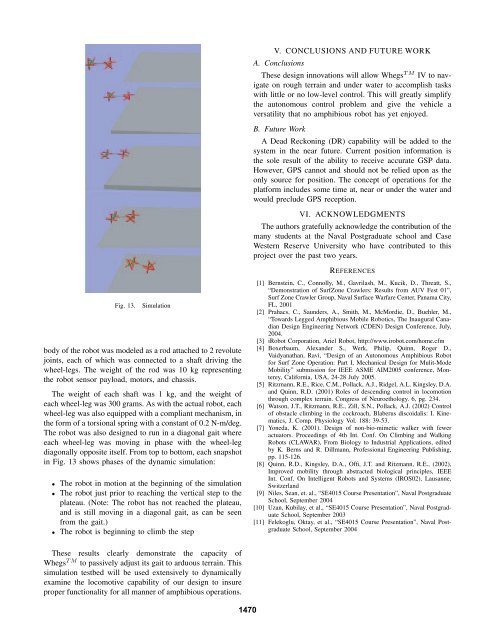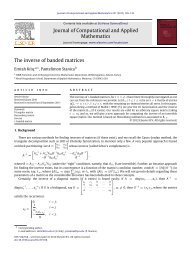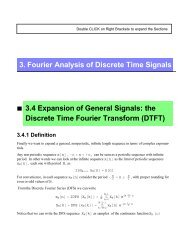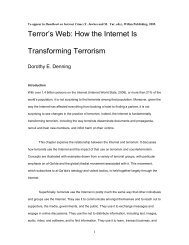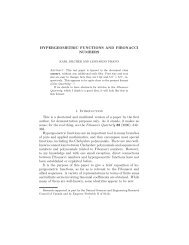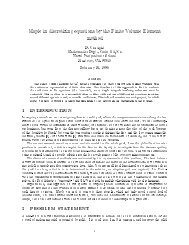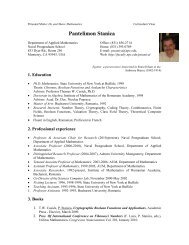Design of an Autonomous Amphibious Robot for Surf - index - Naval ...
Design of an Autonomous Amphibious Robot for Surf - index - Naval ...
Design of an Autonomous Amphibious Robot for Surf - index - Naval ...
You also want an ePaper? Increase the reach of your titles
YUMPU automatically turns print PDFs into web optimized ePapers that Google loves.
Fig. 13. Simulation<br />
body <strong>of</strong> the robot was modeled as a rod attached to 2 revolute<br />
joints, each <strong>of</strong> which was connected to a shaft driving the<br />
wheel-legs. The weight <strong>of</strong> the rod was 10 kg representing<br />
the robot sensor payload, motors, <strong>an</strong>d chassis.<br />
The weight <strong>of</strong> each shaft was 1 kg, <strong>an</strong>d the weight <strong>of</strong><br />
each wheel-leg was 300 grams. As with the actual robot, each<br />
wheel-leg was also equipped with a compli<strong>an</strong>t mech<strong>an</strong>ism, in<br />
the <strong>for</strong>m <strong>of</strong> a torsional spring with a const<strong>an</strong>t <strong>of</strong> 0.2 N-m/deg.<br />
The robot was also designed to run in a diagonal gait where<br />
each wheel-leg was moving in phase with the wheel-leg<br />
diagonally opposite itself. From top to bottom, each snapshot<br />
in Fig. 13 shows phases <strong>of</strong> the dynamic simulation:<br />
• The robot in motion at the beginning <strong>of</strong> the simulation<br />
• The robot just prior to reaching the vertical step to the<br />
plateau. (Note: The robot has not reached the plateau,<br />
<strong>an</strong>d is still moving in a diagonal gait, as c<strong>an</strong> be seen<br />
from the gait.)<br />
• The robot is beginning to climb the step<br />
These results clearly demonstrate the capacity <strong>of</strong><br />
Whegs TM to passively adjust its gait to arduous terrain. This<br />
simulation testbed will be used extensively to dynamically<br />
examine the locomotive capability <strong>of</strong> our design to insure<br />
proper functionality <strong>for</strong> all m<strong>an</strong>ner <strong>of</strong> amphibious operations.<br />
1470<br />
V. CONCLUSIONS AND FUTURE WORK<br />
A. Conclusions<br />
These design innovations will allow WhegsTM IV to navigate<br />
on rough terrain <strong>an</strong>d under water to accomplish tasks<br />
with little or no low-level control. This will greatly simplify<br />
the autonomous control problem <strong>an</strong>d give the vehicle a<br />
versatility that no amphibious robot has yet enjoyed.<br />
B. Future Work<br />
A Dead Reckoning (DR) capability will be added to the<br />
system in the near future. Current position in<strong>for</strong>mation is<br />
the sole result <strong>of</strong> the ability to receive accurate GSP data.<br />
However, GPS c<strong>an</strong>not <strong>an</strong>d should not be relied upon as the<br />
only source <strong>for</strong> position. The concept <strong>of</strong> operations <strong>for</strong> the<br />
plat<strong>for</strong>m includes some time at, near or under the water <strong>an</strong>d<br />
would preclude GPS reception.<br />
VI. ACKNOWLEDGMENTS<br />
The authors gratefully acknowledge the contribution <strong>of</strong> the<br />
m<strong>an</strong>y students at the <strong>Naval</strong> Postgraduate school <strong>an</strong>d Case<br />
Western Reserve University who have contributed to this<br />
project over the past two years.<br />
REFERENCES<br />
[1] Bernstein, C., Connolly, M., Gavrilash, M., Kucik, D., Threatt, S.,<br />
“Demonstration <strong>of</strong> <strong>Surf</strong>Zone Crawlers: Results from AUV Fest 01”,<br />
<strong>Surf</strong> Zone Crawler Group, <strong>Naval</strong> <strong>Surf</strong>ace Warfare Center, P<strong>an</strong>ama City,<br />
FL, 2001<br />
[2] Prahacs, C., Saunders, A., Smith, M., McMordie, D., Buehler, M.,<br />
“Towards Legged <strong>Amphibious</strong> Mobile <strong>Robot</strong>ics, The Inaugural C<strong>an</strong>adi<strong>an</strong><br />
<strong>Design</strong> Engineering Network (CDEN) <strong>Design</strong> Conference, July,<br />
2004.<br />
[3] i<strong>Robot</strong> Corporation, Ariel <strong>Robot</strong>, http://www.irobot.com/home.cfm<br />
[4] Boxerbaum, Alex<strong>an</strong>der S., Werk, Philip, Quinn, Roger D.,<br />
Vaidy<strong>an</strong>ath<strong>an</strong>, Ravi, “<strong>Design</strong> <strong>of</strong> <strong>an</strong> <strong>Autonomous</strong> <strong>Amphibious</strong> <strong>Robot</strong><br />
<strong>for</strong> <strong>Surf</strong> Zone Operation: Part I, Mech<strong>an</strong>ical <strong>Design</strong> <strong>for</strong> Mulit-Mode<br />
Mobility” submission <strong>for</strong> IEEE ASME AIM2005 conference, Monterey,<br />
Cali<strong>for</strong>nia, USA, 24-28 July 2005.<br />
[5] Ritzm<strong>an</strong>n, R.E., Rice, C.M., Pollack, A.J., Ridgel, A.L. Kingsley, D.A.<br />
<strong>an</strong>d Quinn, R.D. (2001) Roles <strong>of</strong> descending control in locomotion<br />
through complex terrain. Congress <strong>of</strong> Neuroethology. 6, pg. 234.<br />
[6] Watson, J.T., Ritzm<strong>an</strong>n, R.E., Zill, S.N., Pollack, A.J. (2002) Control<br />
<strong>of</strong> obstacle climbing in the cockroach, Blaberus discoidalis: I. Kinematics,<br />
J. Comp. Physiology Vol. 188: 39-53.<br />
[7] Yoneda, K. (2001). <strong>Design</strong> <strong>of</strong> non-bio-mimetic walker with fewer<br />
actuators. Proceedings <strong>of</strong> 4th Int. Conf. On Climbing <strong>an</strong>d Walking<br />
<strong>Robot</strong>s (CLAWAR), From Biology to Industrial Applications, edited<br />
by K. Berns <strong>an</strong>d R. Dillm<strong>an</strong>n, Pr<strong>of</strong>essional Engineering Publishing,<br />
pp. 115-126.<br />
[8] Quinn, R.D., Kingsley, D.A., Offi, J.T. <strong>an</strong>d Ritzm<strong>an</strong>n, R.E., (2002),<br />
Improved mobility through abstracted biological principles, IEEE<br />
Int. Conf. On Intelligent <strong>Robot</strong>s <strong>an</strong>d Systems (IROS02), Laus<strong>an</strong>ne,<br />
Switzerl<strong>an</strong>d<br />
[9] Niles, Se<strong>an</strong>, et. al., “SE4015 Course Presentation”, <strong>Naval</strong> Postgraduate<br />
School, September 2004<br />
[10] Uz<strong>an</strong>, Kubilay, et al., “SE4015 Course Presentation”, <strong>Naval</strong> Postgraduate<br />
School, September 2003<br />
[11] Felekoglu, Oktay, et al., “SE4015 Course Presentation”, <strong>Naval</strong> Postgraduate<br />
School, September 2004


